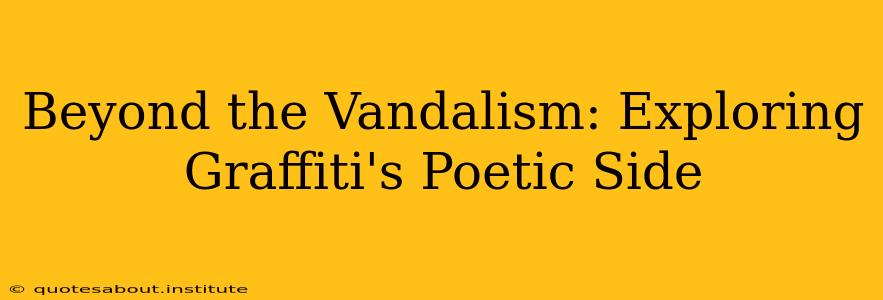Graffiti. The word itself conjures images of defaced walls, illegal tagging, and urban decay. But beyond the vandalism, a powerful form of artistic expression thrives, a vibrant tapestry woven with poetic narratives, social commentary, and breathtaking visuals. This exploration delves into the poetic heart of graffiti, examining its evolution, its cultural significance, and its enduring appeal. We'll move beyond the simple label of "vandalism" and uncover the rich layers of meaning embedded within these often-overlooked works of art.
What is the difference between graffiti and street art?
This is a question frequently asked, and the distinction is often blurry. While both involve art created in public spaces, graffiti typically refers to unauthorized markings, often involving tags (signatures or stylized names) and throw-ups (quick, large-scale pieces). Street art, on the other hand, often involves more elaborate murals and installations, frequently created with the permission of property owners. However, the lines are increasingly blurred, with many artists working across both styles, pushing the boundaries of what constitutes "legal" or "illegal" art. The core difference often lies in intent and the level of artistic complexity and permanence.
Is graffiti art considered vandalism?
The legal definition of graffiti as vandalism is clear-cut in most jurisdictions. Unauthorized markings on private or public property are considered a crime. However, the artistic value of graffiti often transcends its legal status. Many argue that graffiti, particularly intricate murals and politically charged works, should be viewed as public art, deserving of appreciation rather than solely condemnation. This ongoing debate underscores the complex relationship between art, law, and public spaces. The value judgement shifts depending on context, the location, the message, and the artistic merit of the piece itself.
How did graffiti art begin?
Graffiti's roots are surprisingly deep, stretching back to ancient times. From cave paintings to Roman inscriptions, the urge to mark one's presence on public surfaces is a persistent human impulse. However, the modern form of graffiti art, characterized by its stylistic innovations and social commentary, is often traced back to the 1960s and 70s in New York City, evolving alongside hip-hop culture. Early pioneers like TAKI 183 helped establish the foundations of tagging and stylistic experimentation, which subsequently spread globally. This period saw the development of iconic styles, techniques, and a distinct visual language that continues to influence graffiti art today.
What are the different styles of graffiti art?
The spectrum of graffiti styles is remarkably diverse. From simple tags and throw-ups to elaborate murals and intricate stencil work, each style conveys a unique message and demonstrates a different level of artistic skill and commitment. Tagging, the most basic form, involves quickly writing one's name or alias. Throw-ups are larger, bolder pieces often done in a quick, less detailed style. Piece painting involves highly detailed, often multi-layered murals that represent a significant investment of time and skill. Stencils allow for precise reproduction of images and text, while wildstyle involves incredibly complex and interwoven lettering, often defying easy readability. The variety is a testament to graffiti’s inherent adaptability and the boundless creativity of its practitioners.
What is the cultural significance of graffiti art?
Graffiti art is more than just visual aesthetics; it carries profound cultural significance. It serves as a powerful voice for marginalized communities, providing an outlet for expressing social and political critiques. It reflects societal shifts, challenges norms, and pushes creative boundaries. From anti-establishment messages to celebrations of community identity, graffiti frequently acts as a potent form of social commentary, accessible to a wide audience in unconventional spaces. Its ephemeral nature also adds to its allure; it exists in a liminal space between permanence and transience, a constant state of flux mirroring the dynamism of urban life itself.
Conclusion: A Deeper Appreciation
By understanding the context, history, and artistic skill involved, we can appreciate graffiti art beyond its perceived negative connotations. While the unauthorized nature of some graffiti raises valid concerns, recognizing the poetic and cultural dimensions of this expressive art form enhances our understanding of urban landscapes and human creativity. It reminds us that art can exist outside the confines of galleries and museums, thriving in the often-unseen corners of our cities, carrying powerful messages, and offering a unique glimpse into the heart of a culture.

